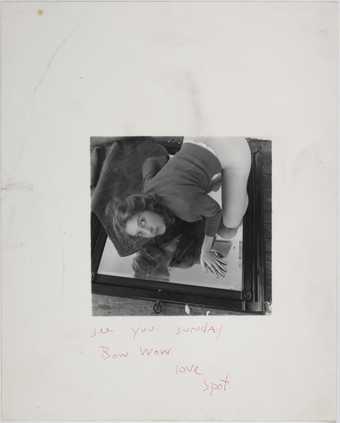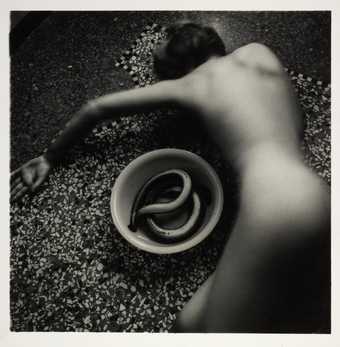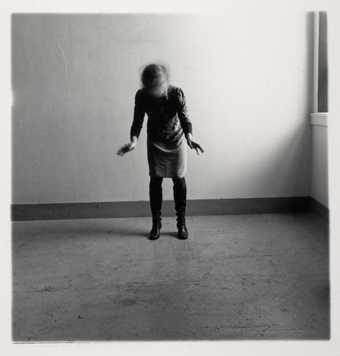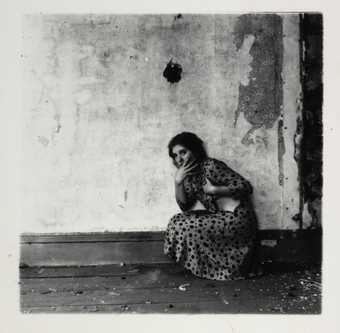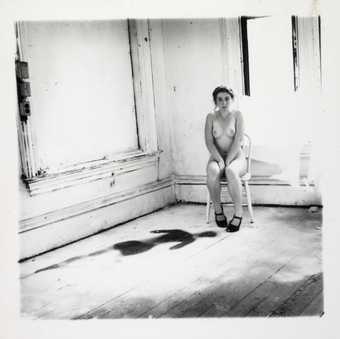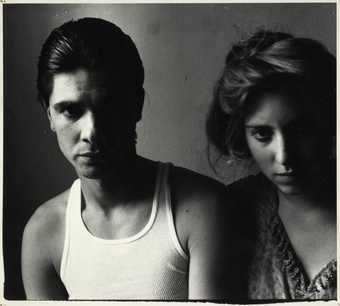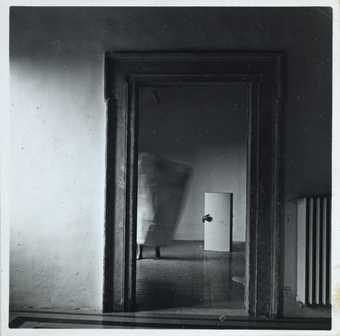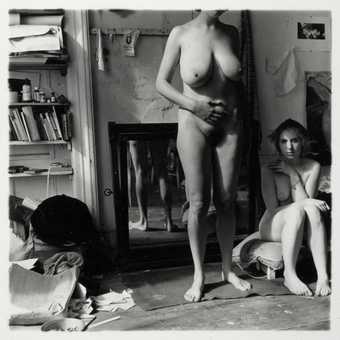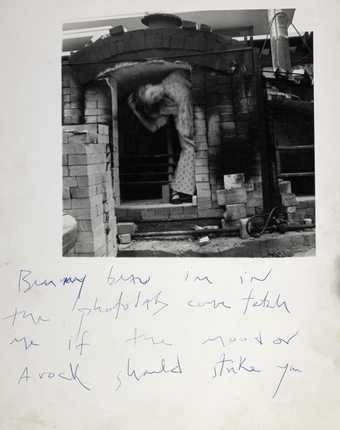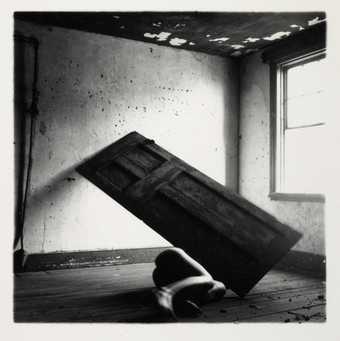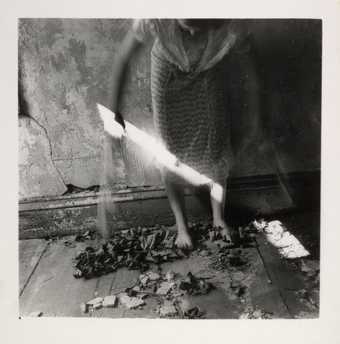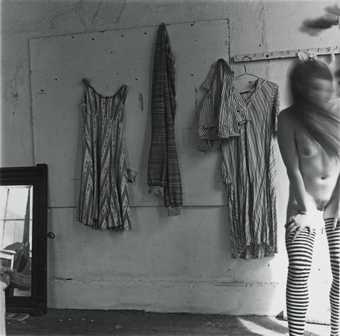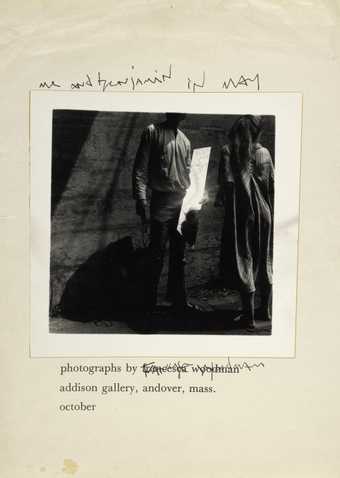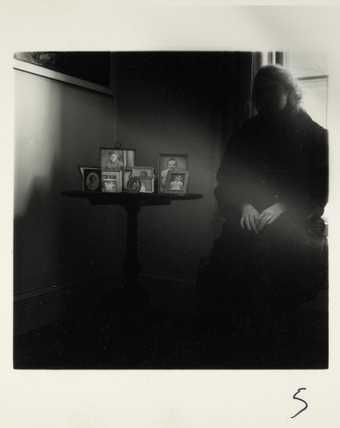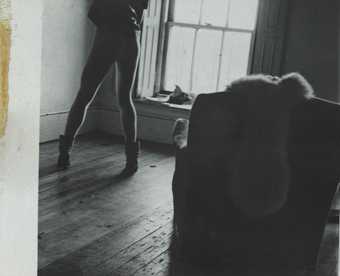
Not on display
- Artist
- Francesca Woodman 1958–1981
- Medium
- Photograph, gelatin silver print on paper
- Dimensions
- Image: 140 × 140 mm
frame: 458 × 402 × 20 mm - Collection
- ARTIST ROOMS Tate and National Galleries of Scotland
- Acquisition
- ARTIST ROOMS Acquired jointly with the National Galleries of Scotland through The d'Offay Donation with assistance from the National Heritage Memorial Fund and the Art Fund 2008
- Reference
- AR00350
Summary
This square-format, black and white photograph is a self-portrait of the artist Francesca Woodman. Woodman, wearing a dark dress and knee length boots, occupies an empty interior space with bare white walls. A dark skirting board runs along the base of the wall where it meets the lighter grey concrete floor. The adjacent wall can be seen on the far right of the image and features a window through which light enters the room. With feet firmly planted, right in front of the left, Woodman appears to lunge forward. Her body is oriented away from the camera; her knees are bent, back hunched and arms stretched out gesturing toward the window. Although her feet are in sharp focus, her body from the ankles up is blurred as if in motion, totally obscuring Woodman’s face.
This photograph was taken in 1976 in Woodman's studio, an unheated room above a dry goods store called Pilgrim Mills, in Providence, Rhode Island. During this time Woodman was a student at the Rhode Island School of Design, where she studied between 1975 and 1977 before moving to Rome with the school’s honours programme, which she completed in 1978. In this image Woodman experimented with exposure time by setting her camera on a slow shutter speed and manipulating the light in order to capture the movement of her body, which blurred her hands and face.
This photograph is part of a series titled Space². Woodman often worked in series, presenting single images under a common title. There are seven photographs in this series, another of which is in the ARTIST ROOMS collection (Tate AR00349). Many of the photographs she took between 1975 and 1978 fulfilled assignments for college. The art historian Rosalind Krauss has suggested that the Space² series corresponded to one such assignment, speculating that Woodman responded to a brief along the lines of ‘Display a particular space by emphasising its character, its geometrics, for example’ (Krauss 2000, p.162). All the images that constitute the Space² series feature the artist’s body in a similar interior space. For this particular image she blurred and distorted her body, while in others she encased herself in glass display cabinets. The title Space² indicates a concern not only with the dimensions of space but with the way in which space is flattened by photography.
Feminist scholar Peggy Phelan has noted that Woodman’s refusal to be still is an essential aspect of her self-portraits, as is evident in this image (Phelan 2002, p.985). The movement captured is intentional, with it Woodman wanted to ‘show you what you do not see – the body’s inner force’ (Woodman quoted in Jui-Ch’i Liu 2004, p.28). Capturing the physicality of the body in motion, the blurs dissolve corporeal boundaries and, according to the critic Jui-Ch’i Liu, register Woodman’s refusal ‘to allow her body to be defined by the viewer’ (Jui-Ch’i Liu 2004, p.28).
The relationship between figure and space explored in this image was further investigated by Woodman on the contact sheet from this photography session, over which she drew extra details on the images with a black marker pen. On this particular image she drew a rectangle resembling a door which her body appears to be stumbling through. Writer Isabella Pedicini has noted that on the Space² proofs Woodman ‘moves through the space again and again, crossing it, jumping over invisible barriers that she later draws in by hand with a black pen. In this way, she maps out a space which is mental, imaginary, and constructed by the movement of her own body.’ (Pedicini 2012, p.72.) Woodman was thoughtful and deliberate in conceptualising her images and used the drawn-on contact sheets during the editing process to identify which photographs to develop. In this way the contact sheet can be seen as a working tool manipulated to produce the final photographic image.
Further reading
Peggy Phelan, ‘Francesca Woodman’s Photography: Death and the Image One More Time’, Signs, vol.27, no.4, Summer 2002, pp.979–1004.
Jui-Ch’i Liu, ‘Francesca Woodman’s Self-Images: Transforming Bodies in the Space of Femininity’, Woman’s Art Journal, vol.25, no.1, Spring–Summer 2004, pp.26–31.
Isabella Pedicini, Francesca Woodman: The Roman Years: Between Skin and Film, Rome 2012.
Susan Mc Ateer
The University of Edinburgh
November 2013
The University of Edinburgh is a research partner of ARTIST ROOMS.
Does this text contain inaccurate information or language that you feel we should improve or change? We would like to hear from you.
Online caption
Woodman’s identity is obscured by the sudden movement of her head, giving her a spectral appearance. This work forms part of a series called ‘Space2’, taken while studying at the Rhode Island School of Design in Providence, Rhode Island between 1975 and 1978. The series explores various ways of concealing or flattening her form, reminding the viewer that all photographs are distortions of reality. Woodman uses a prolonged exposure to create an ethereal, transcendental quality in the tradition of Surrealism. The photograph is not a self-portrait in the conventional sense, as it explores the possibilities of representation instead of revealing the artist’s identity.
Features
Explore
- emotions, concepts and ideas(16,416)
-
- formal qualities(12,454)
-
- blur(210)
- photographic(4,673)
- actions: postures and motions(9,111)
-
- bending forward(353)
- woman(9,110)
You might like
-
Francesca Woodman Untitled, Providence, Rhode Island
1975–6 -
Francesca Woodman Untitled, from Eel Series, Venice, Italy
1978 -
Francesca Woodman Space², Providence, Rhode Island
1976 -
Francesca Woodman Untitled, from Polka Dots Series, Providence, Rhode Island
1976 -
Francesca Woodman Untitled, Providence, Rhode Island
1976 -
Francesca Woodman Untitled, Rome, Italy
1977–8 -
Francesca Woodman Untitled, from Angel Series, Rome, Italy
1977 -
Francesca Woodman Untitled, Providence, Rhode Island
1975–8 -
Francesca Woodman Untitled, Providence, Rhode Island
1975–8 -
Francesca Woodman Untitled, Providence, Rhode Island
1976 -
Francesca Woodman Untitled, Providence, Rhode Island
1975–8 -
Francesca Woodman Untitled, Providence, Rhode Island
1975–8 -
Francesca Woodman Untitled
c.1976 -
Francesca Woodman Untitled, Concord, New Hampshire
1977 -
Francesca Woodman Untitled, New York
1979–80

